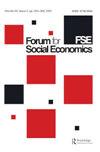The Geographic Redistribution of Income in the United States, 1969–2019: Examining the Role of Federal Policy
IF 1.2
Q4 ECONOMICS
引用次数: 1
Abstract
Abstract Prior research on regional differences in income levels has focused almost exclusively on market mechanisms that affect wages. This article argues that federal policy has had significant effects on changes in regional income inequality, and that these effects have rarely been analyzed. Since 1969, an increase in transfer payments and financial deregulation have increased the share of national income going to transfers and financial income. To show how these changes played out spatially, this article offers a decomposition of the difference in income growth between ten of the fastest-growing metropolitan regions and the United States as a whole, for the period 1969–2019. In most of the regions with the fastest income growth, financial and transfer income account for most of the difference in income growth rates between region and nation. Literature on regional income inequality would benefit from paying more attention to unearned income, and from engaging more fully with literature on financialization.1969-2019年美国收入的地域再分配:对联邦政策作用的审视
摘要先前关于收入水平地区差异的研究几乎完全集中在影响工资的市场机制上。本文认为,联邦政策对地区收入不平等的变化产生了重大影响,而这些影响很少得到分析。自1969年以来,转移支付的增加和金融放松管制增加了国民收入中用于转移支付和金融收入的份额。为了展示这些变化在空间上的表现,本文对1969年至2019年期间十个增长最快的大都市地区与整个美国的收入增长差异进行了分解。在大多数收入增长最快的地区,金融和转移收入是地区和国家收入增长率差异的主要原因。关于区域收入不平等的文献将受益于更多地关注非劳动收入,以及更充分地参与关于金融化的文献。
本文章由计算机程序翻译,如有差异,请以英文原文为准。
求助全文
约1分钟内获得全文
求助全文

 求助内容:
求助内容: 应助结果提醒方式:
应助结果提醒方式:


